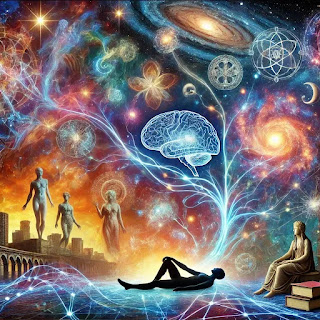How We Feel!
From a scientific perspective, feelings are a combination of physiological reactions, cognitive processing, and psychological experiences that result from various stimuli and internal states.
Here’s a breakdown of how feelings are generated, processed, and experienced:
1. The Role of the Brain
Feelings originate in the brain, primarily in regions like the amygdala, prefrontal cortex, insula, and anterior cingulate cortex.
The amygdala is the emotional center, particularly involved in processing fear and pleasure. It helps the brain recognize threats and rewards and respond with appropriate emotions.
The prefrontal cortex is where higher-order processing occurs, helping us interpret and rationalize our emotions, while the insula plays a role in self-awareness and bodily sensations that contribute to emotions.
2. Neurotransmitters and Hormones
Emotions are largely driven by neurotransmitters (chemical messengers in the brain) and hormones. For example:
Dopamine is linked to pleasure and reward, often activated when we experience something enjoyable or exciting.
Serotonin is associated with mood regulation and well-being. Low serotonin levels are linked to depression.
Oxytocin, sometimes called the "love hormone," is released during bonding experiences like hugging or intimate interactions.
Cortisol and adrenaline are stress hormones that activate the "fight or flight" response when we feel threatened or anxious.
3. The Two-Process Theory of Emotion
This theory suggests that emotions are formed by two main processes: primary appraisal and secondary appraisal.
In primary appraisal, we assess whether a situation is relevant to us and if it's positive, negative, or neutral. This is a quick, almost automatic response.
Secondary appraisal involves a deeper evaluation of the situation, leading us to interpret our emotions and decide how to react.
For instance, seeing a snake might cause an immediate fear response, but secondary appraisal helps us decide if it's dangerous or safe (e.g., behind glass at a zoo).
4. Body’s Physiological Response
Emotions also come with physical responses. For instance, your heart races with fear, you sweat with anxiety, or you feel warm and relaxed when you’re happy.
These responses are regulated by the autonomic nervous system (ANS):
The sympathetic nervous system activates the body’s fight-or-flight response, preparing you to deal with a threat.
The parasympathetic nervous system helps calm the body down, returning it to a resting state after an emotional event.
5. Cognitive Interpretation
Emotions aren’t purely physiological—they’re heavily influenced by how we interpret a situation. This concept is called cognitive appraisal.
Two people might experience the same situation differently based on their beliefs, past experiences, and cultural background. For example, public speaking might make one person excited and another person terrified, based on how each interprets the event.
6. The Limbic System’s Role
The limbic system, which includes the amygdala and hippocampus, is crucial for processing emotions and memories.
The hippocampus connects emotional experiences to memories, which is why certain smells, sights, or sounds can instantly bring back a flood of feelings.
7. The Gut-Brain Connection
Interestingly, feelings are also influenced by the gut-brain axis. The gut contains a vast network of neurons (often called the "second brain") that communicates directly with the brain, impacting mood and emotion.
For example, stress can upset the digestive system, while a healthy gut microbiome has been linked to positive mental health.
8. Cultural and Social Influence on Feelings
While emotions are biological, they are also shaped by social and cultural contexts. Cultures vary in how they express emotions (like happiness, sadness, or anger) and even how they label and understand them. This cultural component can affect how intensely we feel and express certain emotions.
9. Theories on Emotion Development
Scientists have proposed various theories to explain how emotions develop:
Evolutionary theories suggest emotions developed to help humans survive. For example, fear kept us alert to predators, while bonding emotions like love helped with social cohesion.
Constructivist theories propose that emotions are constructed based on experiences and cognitive understanding rather than being innate.
In short, feelings are a rich combination of brain chemistry, biological reactions, cognitive processing, and cultural influences. Feelings are our body’s way of making sense of the world and helping us respond to it effectively.
.......
Feelings are complex, fascinating, and often full of quirky surprises! Here are some funny and unusual facts about them that might give you a new perspective on emotions.
1. Your Brain Can't Tell If You're Faking It
Studies show that if you pretend to be happy by smiling, you actually start to feel happier. This phenomenon, called the facial feedback hypothesis, suggests that the simple act of moving your facial muscles can influence your mood. So, a fake smile might just turn into a real one!
2. Feelings Are Contagious
We “catch” other people’s emotions like a cold. If you're around a grumpy friend, you might start feeling down too. This is because of something called emotional contagion. It’s our brain’s way of syncing up with those around us, making emotions highly social!
3. Stress Can Make You Smarter—But Only a Little
A small amount of stress can actually improve memory and performance, known as eustress, which is a kind of “good stress.” So, those butterflies before a presentation? They might just help you deliver it better.
4. Fear and Excitement Are Very Similar
Your body reacts almost identically to fear and excitement—sweaty palms, racing heart, etc. The main difference is your perception. If you feel safe, the response turns into excitement. So, the next time you feel nervous, think of it as excitement instead. It might make you feel better!
5. Sad Music Makes Us Happy
Oddly, many people enjoy sad music when they're feeling down, as it allows them to process emotions. Neuroscientists think it might be related to nostalgia or even the fact that it’s comforting to feel understood by music, triggering a release of prolactin—a soothing hormone.
6. Anger Can Be Surprisingly Good for You
Despite its reputation, a little anger can be healthy. It can boost creativity, help you stand up for yourself, and even release stress. Just be sure it’s in moderation—there's a fine line between helpful anger and harmful rage!
7. Our Body Has a "Second Brain" for Emotions
The gut actually contains millions of neurons, sometimes called the "second brain." It communicates with our real brain, especially when it comes to emotions. That’s why you get a “gut feeling” or butterflies in your stomach!
8. Laughter Is a Natural Painkiller
Laughter releases endorphins, which can relieve physical pain and elevate mood. Even just anticipating a funny event can reduce stress hormones. In fact, some hospitals use laughter therapy to aid recovery!
9. Love Is Actually a Lot Like Being Addicted
When you're in love, your brain releases dopamine, the same "feel-good" chemical that gets activated with addictive substances. This is why falling in love can feel so exhilarating—and why breakups can be so tough.
10. Tears Serve Different Purposes
Emotional tears have a different chemical composition than reflex tears (like when you chop onions). Emotional tears contain stress hormones, which might explain why we feel relieved after a good cry—it's a natural way for the body to release stress.
Feelings are messy but magical, and science is still working to figure out how they all fit together.






Comments